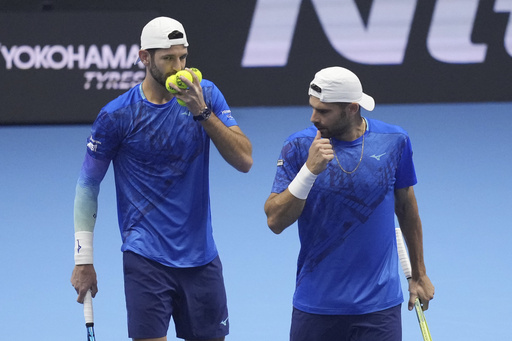
TURIN, Italy — At 44 years old, Indian doubles tennis player Rohan Bopanna continues to thrive in a sport where many athletes retire much earlier. Despite having gray hair in his beard and no cartilage left in his knees, Bopanna has successfully wrapped up a remarkable season in his 21st year on the professional circuit. Among his achievements this year is winning his first Grand Slam men’s doubles title alongside partner Matthew Ebden at the Australian Open, which made him the oldest male player to earn this accolade and achieve a top ranking in doubles.
This week, Bopanna and Ebden are competing at the ATP Finals, the prestigious end-of-season event featuring the eight top doubles teams. So how does Bopanna manage to maintain his fitness and keep performing at such a high level?
“The critical factor is to prioritize your health and well-being,” Bopanna explained, noting that his full-time physical trainer often plays a more significant role in his preparation than even his coach. “It’s about ensuring you do the right warmups, cooldowns, and recovery through methods like ice baths. All of these steps are essential before you even step onto the court. Playing tennis ultimately becomes the easiest part of the process.”
Bopanna is also optimistic about India’s bid for the 2036 Olympics, expressing a desire to continue competing until then. His partner Ebden, who previously won gold at the Olympic Games in Paris, acknowledges Bopanna’s commitment to his fitness regime. “He’s putting in the effort before and after matches, late into the night, even taking ice baths after our matches,” Ebden said, adding that while he provides speed as a player, Bopanna adds power.
Bopanna’s fitness routine includes yoga sessions that range from 20 minutes to an hour and a half. Initially considering inviting his yoga instructor along for his tournaments, he later deemed it financially impractical. “I typically do about 20-30 minutes of yoga each morning. At home, I extend that to a 90-minute session of Iyengar yoga. It’s significantly improved my overall fitness goals,” he remarked.
After this event, Bopanna plans to host a training camp in Mumbai for fellow Indian doubles players, who have performed impressively, with nine others ranked within the top 150 in doubles. “Given the number of players we have in the country, it’s beneficial to gather for a training camp at year’s end to strengthen our foundation for the upcoming season,” he noted.
Bopanna is one of only three Indian men to reach the number one spot in doubles, joining the ranks of Leander Paes and Mahesh Bhupathi, with whom he secured two titles. Additionally, Sania Mirza achieved the number one ranking in women’s doubles, enhancing India’s legacy in the sport.
According to Bopanna, the quick-paced nature of the tennis courts in India contributes to the country’s strong doubles tradition. “There are typically not many rallies,” he stated, explaining that the dry clay courts can be very slippery due to the local weather. “No matter where you are in the country, the courts are generally fast, which fosters better hand-eye coordination for juniors. This coordination has translated well into doubles play.”
Maintaining such dexterity at Bopanna’s age, when most players have retired, is truly impressive.
